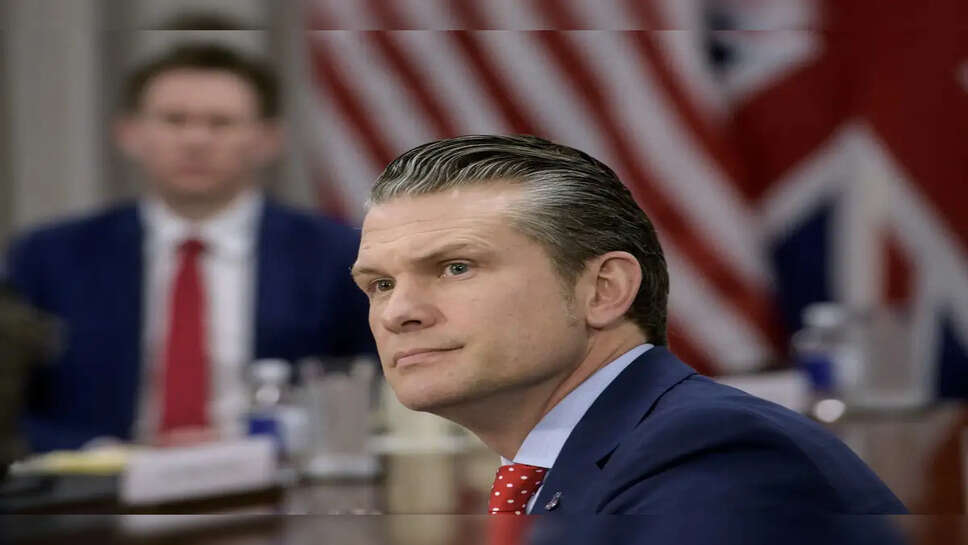Pentagon Chief Hegseth Reveals Trump Still Pursuing Tougher Nuclear Deal with Iran

In a striking assertion that marks a fresh inflection in American foreign policy discourse, the current Pentagon Secretary, Pete Hegseth, has stated that former President Donald Trump is "still aiming" to secure a new nuclear deal with Iran. Hegseth’s remarks come only weeks after Trump announced his candidacy for the 2024 presidential election, spotlighting Iran as a central element of his anticipated foreign policy platform. According to Hegseth, despite the “maximum pressure” campaign and Iran’s growing nuclear advancements, Trump continues to pursue an agreement—albeit one featuring substantially tougher conditions than the 2015 Joint Comprehensive Plan of Action (JCPOA).
1. A Renewed Approach?
Hegseth framed the development of a new Iran deal as part of a broader reset of American strategy. He described Trump’s ongoing tracking of Iran’s growing uranium-enrichment capacity and stated that the former president is interested in reaching terms that both curtail Iran’s nuclear capability and secure a long-term commitment to preventing weapons development. Key elements reportedly under consideration:
-
A longer duration for key nuclear constraints (e.g., extending restrictions from 10 years to 20 years).
-
Stricter inspections and verification via the International Atomic Energy Agency (IAEA), with immediate access and no delay.
-
Codified and legally binding mechanisms to ensure that U.S. withdrawal from the deal, and re-imposition of sanctions, can occur swiftly if Iran violates its terms.
Hegseth stressed that Trump is viewing this as a “leverage reset”—using America’s industrial and diplomatic strength to bring Iran back to the table under tougher conditions than before.
2. Continuity and Departure from 2015
When the Obama-era JCPOA was struck in 2015, it lifted key Iranian sanctions in return for nuclear curbs. The Obama administration promoted it as the best way to curb Iran’s ability to build an atomic weapon. Critics, including Trump, argued that the deal included sunset clauses, imposed limited access for inspectors, and allowed delays in snapback monitoring. Trump withdrew the U.S. from the agreement in 2018, imposing “maximum pressure” sanctions, prompting Iran to resume uranium enrichment beyond JCPOA limits.
Hegseth suggests that Trump is prepared to walk back into negotiations—but only if a rebuilt deal is significantly strengthened. This would contrast with earlier U.S. policy under Trump, in which penalties were prioritized to weaken Iran’s economic base.
3. Political Context & Messaging
For Trump, this renewed position on Iran could serve several political objectives:
-
Presidential Positioning: As he positions himself in the upcoming election cycle, a foreign policy achievement could help him recover the image of America-first strength while rehabilitating political reputation on global matters.
-
Contrast with Biden: Trump may present the new deal as either a tougher alternative to the Obama JCPOA or a more resolute version of the negotiations pursued under President Biden.
-
Coalition Building: A deal proposed with stronger inspections might reassure Israeli, Gulf Arab, and European leaders who have expressed enduring skepticism about Iran’s ambitions.
Hegseth’s confirmation underscores that Trump has not abandoned nuclear talks altogether, but is seeking to press for a tougher pact under American pressure.
4. Strategic Shift: Talks via Pressure
At heart, this proposed strategy reaffirms a belief that diplomacy backed by overwhelming strength is most effective. Hegseth explains that Trump views diplomacy and pressure as complementary—sanctions foster leverage; negotiations convert leverage into enforceable terms.
This contrasts with purely diplomatic—“give to get” style negotiation and outright military action, which Trump has also at times threatened. The current line seems to blend both tough economic coercion and potential military deterrence with a pathway to a more durable accord.
5. Reaction from Tehran
Tehran’s likely response could be mixed. A negotiating reset with tougher terms may not excite Iranian hardliners, who see American influence as malign. However, pragmatists within Tehran, seeking economic relief and avoidance of further escalation, might cautiously consider a possible new deal.
Trump's reputation for unpredictability could affect Iran’s willingness. They may wonder if a deal struck today would persist if Trump wins the presidency but loses a potential second term.
6. Backlash from Allies and Congress
A Trump-era “tougher deal” could make some European allies more amenable, particularly if inspectors are given wider access and nuclear “sunsets” are extended. Israel might also be sensitive—acceptance will depend on whether any emerging plan includes credible means to halt uranium enrichment in perpetuity or drastic military enforcement scenarios.
On Capitol Hill, the reaction would depend on which parliamentarians shape the outcome. Human rights advocates, anti-nuclear groups, and GOP hawks will scrutinize:
-
Will sanctions be fully lifted?
-
Is compliance verifiable and irreversible?
-
Is the deal purely nuclear, or does it address ballistic missiles or regional aggression?
Congressional politics will shape how any deal is approved and ratified.
7. Potential Challenges Ahead
Negotiating a tougher deal will involve several obstacles:
-
Defining credible snapback: Agreements will need airtight language to ensure quick re-imposition of sanctions if Iran violates commitments.
-
Monitoring and compliance: Iran’s remote sites and underground facilities require 24/7 IAEA access.
-
Political durability: Deals must survive beyond a single administration and become embedded in national U.S. law or international treaty frameworks.
-
Regional buy-in: Neighboring Middle Eastern states must feel protected to prevent a regional arms race.
8. Broader Implications for U.S. Foreign Policy
Trump’s evolving position underscores a broader debate over how the U.S. engages adversaries—through isolation, war, or tough negotiation. Under this emerging strategy:
-
Isolation is replaced with sustained engagement, but on America’s terms.
-
Diplomacy and deterrence fuse into what Hegseth calls “maximum leverage diplomacy.”
-
Global perception of American resolve may increase if the U.S. is seen as proactive rather than withdrawn.
At the same time, critics argue this perpetuates volatility and risks sudden reversal, undermining long-term trust.
9. What's Next?
Hegseth’s statement suggests the Trump campaign may seek to:
-
Open debate in the foreign policy community.
-
Outline a roadmap for talks tied to frameworks already shaped by IAEA principles.
-
Build coalitions with vocal allies (e.g., EU, Israel, Arab nations, India) to ensure buy-in.
-
Engage Congress with draft legislation carrying congressional oversight (e.g., sanctions relief conditional on verification).
-
Signal Iran that tough terms might be negotiable—if Iran shows restraint.
Pentagon Secretary Pete Hegseth’s comments regarding Trump’s continued interest in a nuclear deal with Iran mark a strategic pivot. It combines pressure-based deterrence with a renewed willingness to negotiate. The stakes include halt of nuclear proliferation, regional security, and America’s global posture. But success will depend on whether all sides—Washington, Tehran, Congress, and regional allies—find terms that are enforceable, transparent, and politically acceptable on all fronts.
It remains to be seen whether this proposed model—“maximum leverage diplomacy”—can turn confrontation into agreement, avoidance of nuclear weapons into enforceable reality, and campaign rhetoric into actual policy. But if nothing else, it signals that even as former presidents activate platforms for reelection, nuclear diplomacy remains too consequential to leave behind.
"Pentagon's Hegseth: Trump Still Seeking Tougher Iran Nuclear Deal—‘Maximum Leverage Diplomacy’ in Focus
